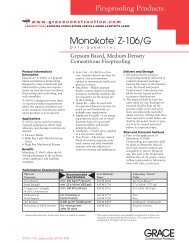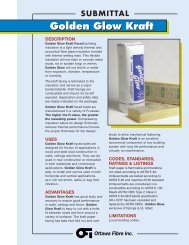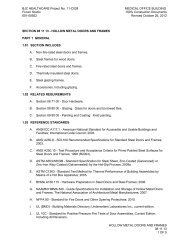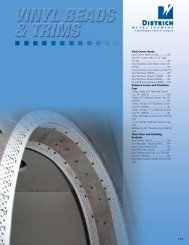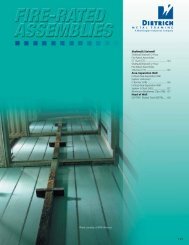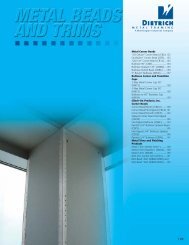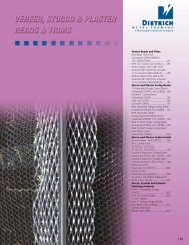Metal Lath Galvanized Junior™ Mesh (LAM) (P)* (O)* (S ...
Metal Lath Galvanized Junior™ Mesh (LAM) (P)* (O)* (S ...
Metal Lath Galvanized Junior™ Mesh (LAM) (P)* (O)* (S ...
You also want an ePaper? Increase the reach of your titles
YUMPU automatically turns print PDFs into web optimized ePapers that Google loves.
Paper-Backed<br />
Offset Options<br />
<strong>Metal</strong> lath is available<br />
backed with asphalt saturated<br />
paper for applications<br />
requiring a<br />
moisture barrier. Paper<br />
conforms to Federal<br />
Specification UU-B-<br />
790a, type 1, grade D,<br />
style 2. Dietrich uses a lettering system incorporated into<br />
the product code to indicate available offsets.<br />
Types<br />
P—Paper is offset by 1" on one side<br />
and one end.*<br />
O—Paper is offset by 2" on one side<br />
and one end.<br />
S—Paper is offset by 1" on one end.<br />
Sides are not offset.*<br />
K—Specially applied Kraft paper for<br />
use with machine-applied stucco<br />
to minimize plaster waste.<br />
*Available for non-code work. The Uniform Building Code<br />
(UBC) requires a 2" paper lap per ASTM C 1063-99.<br />
Junior Diamond <strong>Mesh</strong> <strong>Lath</strong> is used as a substrate for gypsum<br />
plaster or for Portland cement plaster stucco on either<br />
interior or exterior wall, ceiling, soffit and fascia surfaces, and<br />
can be used under ceramic tile in wall ceiling and floor applications.<br />
It’s useful in all general-purpose applications, and is the<br />
best lath available for ornamental work and contoured surfaces.<br />
Junior Diamond <strong>Mesh</strong> <strong>Lath</strong>—Asphalt Paper Backed is<br />
used in applications where a moisture barrier is required.<br />
Care should be taken to make sure paper overlaps paper and<br />
metal overlaps metal in a shingle-like manner during application.<br />
Dietrich’s paper backing extends beyond the mesh<br />
to accommodate shingling application. For external application,<br />
3.4 lb./sq. yd. lath is recommended.<br />
Self-Furring Junior Diamond <strong>Mesh</strong> <strong>Lath</strong> is attached to<br />
substrate through the dimple that furs the lath surface away<br />
from a solid substrate. This lath is especially useful as a stucco<br />
base or for column fireproofing or replastering over old<br />
surfaces. Self-furred lath is required over all solid surfaces.<br />
Self-Furring Junior Diamond <strong>Mesh</strong> <strong>Lath</strong>-Asphalt<br />
Paper Backed is used where a moisture barrier is required.<br />
It’s attached in the same manner, but care should be taken<br />
to make sure paper overlaps paper during application.<br />
For more information or to contact a sales representative, see page 3.<br />
Overview<br />
4-<strong>Mesh</strong> Z-Riblath is used wherever sound, flat surfaces are<br />
required. Nail, staple or screw-attach lath to framing with<br />
ribs perpendicular to wall studs. Z-Riblath is tied to suspended<br />
ceilings but can be nailed, stapled or screwed to the<br />
ceiling joists for direct applications. Flat rib lath should<br />
never be used over solid surfaces.<br />
3/8" Riblath is the most rigid of all and provides the added<br />
support required when framing is more than 16" O.C. but<br />
less than or equal to 24" O.C. In wall and ceiling applications,<br />
it must be attached in the same manner as 4-<strong>Mesh</strong> Riblath.<br />
Due to 3/8" rib, minimum ground thickness must be 1".<br />
Barrier <strong>Mesh</strong> is a tough, rigid heavy-gauge expanded mesh<br />
used behind common wall substrates to protect against breakins<br />
and break-outs. This high-strength security mesh is tough to<br />
smash or cut and safeguards walls and ceilings in homes, apartments,<br />
offices, stores, storage areas and correctional facilities.<br />
Installation<br />
<strong>Lath</strong> should be applied with the long<br />
dimension across supports and with end<br />
joints staggered between courses. The<br />
ends of the mesh lath should be lapped 1",<br />
and the sides should be lapped at least<br />
1/2". Check lap minimums required by<br />
local code. Nail, screw or staple-attach<br />
mesh lath on walls, so that the lower sheets<br />
overlap the upper sheets. <strong>Lath</strong> also may be<br />
wire tied to the furring channel for ceiling applications. If an<br />
end lap should occur between supports, the two sheets<br />
should be laced or tied using 18-gauge tie wire. Secure lath to<br />
all supports at intervals not exceeding 6". <strong>Mesh</strong> lath should be<br />
formed into corners and carried out onto an abutting surface.<br />
Where this is not possible, Cornerite, an internal plaster angle<br />
reinforcement should be used.<br />
Paper-Back Installation<br />
Installation of paper-backed lath is best accomplished when<br />
metal-to-metal and paper-to-paper contact is maintained.<br />
Dietrich <strong>Metal</strong> Framing uses asphalt-saturated paper meeting<br />
Federal Spec. UU-B-790a as backing on metal lath products.<br />
This paper provides a water- resistant barrier that is a<br />
vapor-permeable backing consistent with grade D, style 2<br />
paper (other grades and styles are available upon request).<br />
Minimum lap requirement for Jr. Diamond <strong>Mesh</strong>, Self-<br />
Furring and 1/8" Flat Rib <strong>Lath</strong>s is 1/2" at the sides and 1" on<br />
the ends which can be easily attained with either “P” (paper<br />
offset 1" on one side and one end) or “S” (paper flush on<br />
sides and offset 1" on ends) applications. ASTM C-1063,<br />
requires a 2" minimum paper lap on all sides. Dietrich’s<br />
paper offset option “O” conforms to<br />
this specification. Make sure to consult<br />
your local building code to<br />
ensure proper compliance.<br />
<strong>Metal</strong> <strong>Lath</strong> Overview<br />
207




